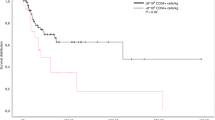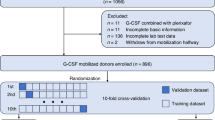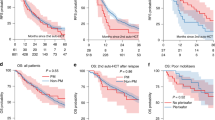Abstract
In an otherwise eligible patient with relapsed lymphoma, inadequate mobilization of hematopoietic stem cells (HSCs) is a limiting factor to proceeding with an autologous hematopoietic cell transplantation (auto-HCT). Multiple strategies have been used to mobilize an adequate number of HSCs with no obvious front-line strategy. We report a single institutional experience mobilizing HSCs using four different approaches in lymphoma patients. We prospectively collected mobilization outcomes on patients planned to undergo auto-HCT at Ohio State University. We report results of first mobilization attempts for all relapsed or refractory lymphoma patients between 2008 and 2014. We identified 255 lymphoma patients who underwent mobilization for planned auto-HCT. The 255 lymphoma patients underwent the following front line mobilization strategies: 95 (37%) G-CSF alone, 38 (15%) chemomobilization (G-CSF+chemotherapy), 97 (38%) preemptive day 4 plerixafor, and 25 (10%) rescue day 5 plerixafor. As expected, there were significant differences between cohorts including age, comorbidity indices, histology, and amount of prior chemotherapy. After controlling for differences between groups, the odds of collecting 2 × 106/kg HSCs on the first day of collection and 5 × 106/kg HSCs in total was the highest in the cohort undergoing chemomobilization. In conclusion, our experience highlights the effectiveness of chemomobilization.
This is a preview of subscription content, access via your institution
Access options
Subscribe to this journal
Receive 12 print issues and online access
$259.00 per year
only $21.58 per issue
Buy this article
- Purchase on SpringerLink
- Instant access to full article PDF
Prices may be subject to local taxes which are calculated during checkout

Similar content being viewed by others
References
Sheppard D, Bredeson C, Allan D, Tay J . Systematic review of randomized controlled trials of hematopoietic stem cell mobilization strategies for autologous transplantation for hematologic malignancies. Biol Blood Marrow Transplant 2012; 18: 1191–1203.
Devine SM, Flomenberg N, Vesole DH, Liesveld J, Weisdorf D, Badel K et al. Rapid mobilization of CD34+ cells following administration of the CXCR4 antagonist AMD3100 to patients with multiple myeloma and non-Hodgkin's lymphoma. J Clin Oncol 2004; 22: 1095–1102.
Flomenberg N, Devine SM, Dipersio JF, Liesveld JL, McCarty JM, Rowley SD et al. The use of AMD3100 plus G-CSF for autologous hematopoietic progenitor cell mobilization is superior to G-CSF alone. Blood 2005; 106: 1867–1874.
DiPersio JF, Micallef IN, Stiff PJ, Bolwell BJ, Maziarz RT, Jacobsen E et al. Phase III prospective randomized double-blind placebo-controlled trial of plerixafor plus granulocyte colony-stimulating factor compared with placebo plus granulocyte colony-stimulating factor for autologous stem-cell mobilization and transplantation for patients with non-Hodgkin's lymphoma. J Clin Oncol 2009; 27: 4767–4773.
DiPersio JF, Stadtmauer EA, Nademanee A, Micallef IN, Stiff PJ, Kaufman JL et al. Plerixafor and G-CSF versus placebo and G-CSF to mobilize hematopoietic stem cells for autologous stem cell transplantation in patients with multiple myeloma. Blood 2009; 113: 5720–5726.
Chabannon C, Bijou F, Miclea JM, Milpied N, Grouin JM, Mohty M . A nationwide survey of the use of plerixafor in patients with lymphoid malignancies who mobilize poorly demonstrates the predominant use of the ‘on-demand’ scheme of administration at French autologous hematopoietic stem cell transplant programs. Transfusion 2015; 55: 2149–2157.
Sheppard D, Bredeson C, Huebsch L, Allan D, Tay J . A plerixafor-based strategy allows adequate hematopoietic stem cell collection in poor mobilizers: results from the Canadian Special Access Program. Bone Marrow Transplant 2014; 49: 751–755.
Cheng J, Schmitt M, Wuchter P, Buss EC, Witzens-Harig M, Neben K et al. Plerixafor is effective given either preemptively or as a rescue strategy in poor stem cell mobilizing patients with multiple myeloma. Transfusion 2015; 55: 275–283.
Veeraputhiran M, Jain T, Cronin S, Al-Kadhimi Z, Abidi MH, Ayash L et al. Successful hematopoietic stem cell collection in patients who fail initial plerixafor mobilization for autologous stem cell transplant. J Clin Apher 2014; 29: 293–298.
Storch E, Mark T, Avecilla S, Pagan C, Rhodes J, Shore T et al. A novel hematopoietic progenitor cell mobilization and collection algorithm based on preemptive CD34 enumeration. Transfusion 2015; 55: 2010–2016.
Chow E, Rao KV, Wood WA, Covington D, Armistead PM, Coghill J et al. Effectiveness of an algorithm-based approach to the utilization of plerixafor in patients undergoing chemotherapy-based stem cell mobilization. Biol Blood Marrow Transplant 2014; 20: 1064–1068.
Bilgin YM, Visser O, Beckers EA, te Boome LC, Huisman C, Ypma PF et al. Evaluation of Dutch guideline for just-in-time addition of plerixafor to stem cell mobilization in patients who fail with granulocyte-colony-stimulating factor. Transfusion 2015; 55: 1021–1027.
Jagasia MH, Savani BN, Neff A, Dixon S, Chen H, Pickard AS . Outcome, toxicity profile and cost analysis of autologous stem cell mobilization. Bone Marrow Transplant 2011; 46: 1084–1088.
Heizmann M, O'Meara AC, Moosmann PR, Heijnen IA, Zuberbuhler M, Fernandez P et al. Efficient mobilization of PBSC with vinorelbine/G-CSF in patients with malignant lymphoma. Bone Marrow Transplant 2009; 44: 75–79.
Copelan E, Pohlman B, Rybicki L, Kalaycio M, Sobecks R, Andresen S et al. A randomized trial of etoposide and G-CSF with or without rituximab for PBSC mobilization in B-cell non-Hodgkin's lymphoma. Bone Marrow Transplant 2009; 43: 101–105.
Mahindra A, Bolwell BJ, Rybicki L, Elder P, Kalaycio M, Dean R et al. Etoposide plus G-CSF priming compared with G-CSF alone in patients with lymphoma improves mobilization without an increased risk of secondary myelodysplasia and leukemia. Bone Marrow Transplant 2012; 47: 231–235.
Hartmann T, Hubel K, Monsef I, Engert A, Skoetz N . Additional plerixafor to granulocyte colony-stimulating factors for haematopoietic stem cell mobilisation for autologous transplantation in people with malignant lymphoma or multiple myeloma. Cochrane Database of Syst Rev 2015; 10: Cd010615.
To LB, Levesque JP, Herbert KE . How I treat patients who mobilize hematopoietic stem cells poorly. Blood 2011; 118: 4530–4540.
Stiff PJ . Management strategies for the hard-to-mobilize patient. Bone Marrow Transplant 1999; 23 (Suppl 2): S29–S33.
Hosing C, Saliba RM, Ahlawat S, Korbling M, Kebriaei P, Alousi A et al. Poor hematopoietic stem cell mobilizers: a single institution study of incidence and risk factors in patients with recurrent or relapsed lymphoma. Am J Hematol 2009; 84: 335–337.
Veltri L, Cumpston A, Shillingburg A, Wen S, Luo J, Leadmon S et al. Hematopoietic progenitor cell mobilization with ‘just-in-time’ plerixafor approach is a cost-effective alternative to routine plerixafor use. Cytotherapy 2015; 17: 1785–1792.
Micallef IN, Apostolidis J, Rohatiner AZ, Wiggins C, Crawley CR, Foran JM et al. Factors which predict unsuccessful mobilisation of peripheral blood progenitor cells following G-CSF alone in patients with non-Hodgkin's lymphoma. Hematol J 2000; 1: 367–373.
Kuittinen T, Nousiainen T, Halonen P, Mahlamaki E, Jantunen E . Prediction of mobilisation failure in patients with non-Hodgkin's lymphoma. Bone marrow Transplant 2004; 33: 907–912.
Clark RE, Brammer CG . Previous treatment predicts the efficiency of blood progenitor cell mobilisation: validation of a chemotherapy scoring system. Bone Marrow Transplant 1998; 22: 859–863.
Tournilhac O, Cazin B, Lepretre S, Divine M, Maloum K, Delmer A et al. Impact of frontline fludarabine and cyclophosphamide combined treatment on peripheral blood stem cell mobilization in B-cell chronic lymphocytic leukemia. Blood 2004; 103: 363–365.
Hill BT, Rybicki L, Smith S, Dean R, Kalaycio M, Pohlman B et al. Treatment with hyperfractionated cyclophosphamide, vincristine, doxorubicin, and dexamethasone combined with cytarabine and methotrexate results in poor mobilization of peripheral blood stem cells in patients with mantle cell lymphoma. Leukemia Lymphoma 2011; 52: 986–993.
Kumar S, Giralt S, Stadtmauer EA, Harousseau JL, Palumbo A, Bensinger W et al. Mobilization in myeloma revisited: IMWG consensus perspectives on stem cell collection following initial therapy with thalidomide-, lenalidomide-, or bortezomib-containing regimens. Blood 2009; 114: 1729–1735.
Lanza F, Lemoli RM, Olivieri A, Laszlo D, Martino M, Specchia G et al. Factors affecting successful mobilization with plerixafor: an Italian prospective survey in 215 patients with multiple myeloma and lymphoma. Transfusion 2014; 54: 331–339.
Rossi G, Skert C, Morello E, Almici C, Arcaini L, Basilico C et al. PBSC mobilization in lymphoma patients: analysis of risk factors for collection failure and development of a predictive score based on the kinetics of circulating CD34+ cells and WBC after chemotherapy and G-CSF mobilization. Hematol Oncol 2015; 33: 125–132.
Haverkos BM, McBride A, O'Donnell L, Scholl D, Whittaker B, Vasu S et al. An effective mobilization strategy for lymphoma patients after failed upfront mobilization with plerixafor. Bone Marrow Transplant 2014; 49: 1052–1055.
Wood WA, Whitley J, Goyal R, Brown PM, Sharf A, Irons R et al. Effectiveness of etoposide chemomobilization in lymphoma patients undergoing auto-SCT. Bone Marrow Transplant 2013; 48: 771–776.
Dhakal B, Veltri LW, Fenske TS, Eastwood D, Craig MD, Cumpston A et al. Hematopoietic progenitor cell mobilization with ICE chemotherapy versus plerixafor-based strategies in patients with hodgkin and non-hodgkin lymphoma. Biol Blood Marrow Transplant 2016; 22: 1773–1780.
Clark RE, Bell J, Clark JO, Braithwaite B, Vithanarachchi U, McGinnity N et al. Plerixafor is superior to conventional chemotherapy for first-line stem cell mobilisation, and is effective even in heavily pretreated patients. Blood Cancer J 2014; 4: e255.
Acknowledgements
BH was supported by the National Cancer Institute within the National Institutes of Health under Award Number T32CA165998 at the time this study was initiated.
Author information
Authors and Affiliations
Corresponding authors
Ethics declarations
Competing interests
The authors declare no conflict of interest.
Additional information
Supplementary Information accompanies this paper on Bone Marrow Transplantation website
Rights and permissions
About this article
Cite this article
Haverkos, B., Huang, Y., Elder, P. et al. A single center’s experience using four different front line mobilization strategies in lymphoma patients planned to undergo autologous hematopoietic cell transplantation. Bone Marrow Transplant 52, 561–566 (2017). https://doi.org/10.1038/bmt.2016.304
Received:
Revised:
Accepted:
Published:
Issue date:
DOI: https://doi.org/10.1038/bmt.2016.304



